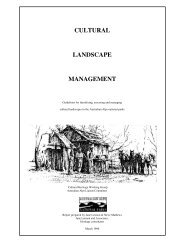Mining Heritage of the Australian Alps - Australian Alps National Parks
Mining Heritage of the Australian Alps - Australian Alps National Parks
Mining Heritage of the Australian Alps - Australian Alps National Parks
Create successful ePaper yourself
Turn your PDF publications into a flip-book with our unique Google optimized e-Paper software.
3.4 MINING CULTURAL LANDSCAPES<br />
<strong>Mining</strong> is an important historical <strong>the</strong>me in Australia, and mining cultural landscapes exist around <strong>the</strong><br />
continent. Outstanding mining landscapes are numerous, and include those <strong>of</strong> Broken Hill, NSW,<br />
Kalgoorlie, WA, <strong>the</strong> central Victorian goldfields, <strong>the</strong> 'moonscapes' <strong>of</strong> Coober Pedy, SA, etc.<br />
Cultural landscapes exist throughout <strong>the</strong> <strong>Alps</strong>, and reflect <strong>the</strong> hand <strong>of</strong> man in <strong>the</strong> environment. No<br />
integrated <strong>Alps</strong>-wide studies <strong>of</strong> cultural landscapes have yet been undertaken 7 , and <strong>the</strong> identification<br />
<strong>of</strong> mining-related cultural landscapes has been very limited to date.<br />
<strong>Mining</strong> was a strong modifying influence in <strong>the</strong> <strong>Alps</strong>, imposing roads, tracks, diggings, mining<br />
infrastructure and settlements on <strong>the</strong> landscape, and requiring resources such as timber and water for<br />
its mines, and sustenance for its workers. In general, this study has found that recognisable and<br />
interpretable mining landscapes within <strong>the</strong> <strong>Alps</strong> national parks are very rare. They exist in very few<br />
environments, and are restricted to <strong>the</strong> very highest part <strong>of</strong> <strong>the</strong> <strong>Alps</strong> (open, grassy, lightly-treed areas),<br />
or to <strong>the</strong> wider, low-lying river valleys. In between, <strong>the</strong> regrowing forest now cloaks <strong>the</strong> mining<br />
features, and viewlines are interrupted by <strong>the</strong> rugged topography.<br />
No outstanding quartz mining landscapes have been located, and this is in part attributable to <strong>the</strong> fact<br />
that larger scale operations are horizontally-layered in mountainous terrain. Consequently, <strong>the</strong><br />
worked levels may be some distance apart, and <strong>the</strong> processing plant may be situated well away from<br />
<strong>the</strong> workings. Occupation sites may be close to workings or plant, but may be nucleated in mining<br />
camps that serve a quartz mining area.<br />
In tall, dense, natural or regrowing forest, <strong>the</strong>re will be few opportunities to establish viewlines that<br />
convey <strong>the</strong> broader aspects <strong>of</strong> a single operation, let alone its relationship and linkages to associated<br />
cultural heritage features. While mining-related cultural landscapes are immediately visible in areas<br />
such as Kiandra, in o<strong>the</strong>r abandoned mining areas <strong>the</strong>y can be cryptic, and <strong>the</strong>ir cloak <strong>of</strong> vegetation<br />
(albeit altered) minimises <strong>the</strong>ir value as interpretable cultural landscapes. Integrity, relating to<br />
visibility <strong>of</strong> <strong>the</strong> features, is <strong>the</strong> key factor in assessing cultural landscapes.<br />
For instance, <strong>the</strong> East Branch <strong>of</strong> <strong>the</strong> Ovens River (Bogong Unit, Alpine <strong>National</strong> Park) contains an<br />
abundance <strong>of</strong> mining features. There is extensive ground and hydraulic sluicing, abundant large and<br />
small-scale reef mining, settlement sites, linear features including water races, level & inclined<br />
tramways, a network <strong>of</strong> mining roads, two Department-financed mining tracks etc. However, views<br />
over <strong>the</strong> valley reveal none <strong>of</strong> this. The hills that were once stripped bare <strong>of</strong> timber appear as a<br />
seamless pristine wilderness to <strong>the</strong> untrained eye, and <strong>the</strong>y have nei<strong>the</strong>r value for broad-scale<br />
interpretation nor requirement for landscape-related management action.<br />
David Bannear, in his draft "Conservation Plan for Historic Gold <strong>Mining</strong> Sites" (1996, DNRE), tacitly<br />
acknowledges this poor landscape integrity in regrowing forested areas:<br />
"Themes evoked by sites in regrowing forests are about adventurousness, hardship<br />
and isolation <strong>of</strong> mining life. Coupled with <strong>the</strong> physical effort <strong>of</strong> getting to a site<br />
today, <strong>the</strong>se images make a powerful experience. The experience is generally quite<br />
site specific with <strong>the</strong> surviving mining relics alongside regrowing forest combining to<br />
give <strong>the</strong> place a strong evocation <strong>of</strong> abandonment, decay and a way <strong>of</strong> life now<br />
gone."<br />
A number <strong>of</strong> <strong>Alps</strong> mining landscapes are identified and described in section 4.8 <strong>of</strong> this report.<br />
7 "<strong>Australian</strong> <strong>Alps</strong> Cultural Landscape Management Guidelines", Jane Lennon & Associates, 1996, p34.<br />
18

















